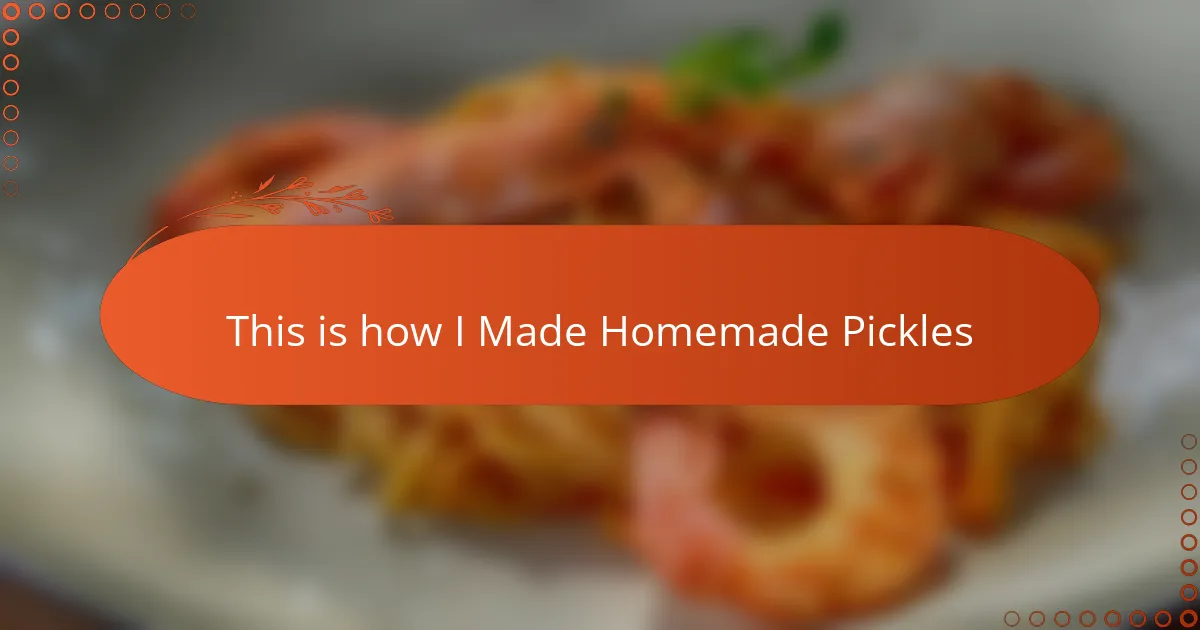Key takeaways
- Homemade pickles rely on the right balance of vinegar, water, salt, and sometimes sugar to preserve flavor and freshness.
- Using fresh, firm cucumbers and controlling brine temperature are crucial for achieving the perfect crunch.
- Proper storage in a cool, dark place and refrigeration after opening help maintain the crispness and flavor of pickles.
- Experimenting with different vinegars and salt types can enhance the pickling experience and flavor outcomes.
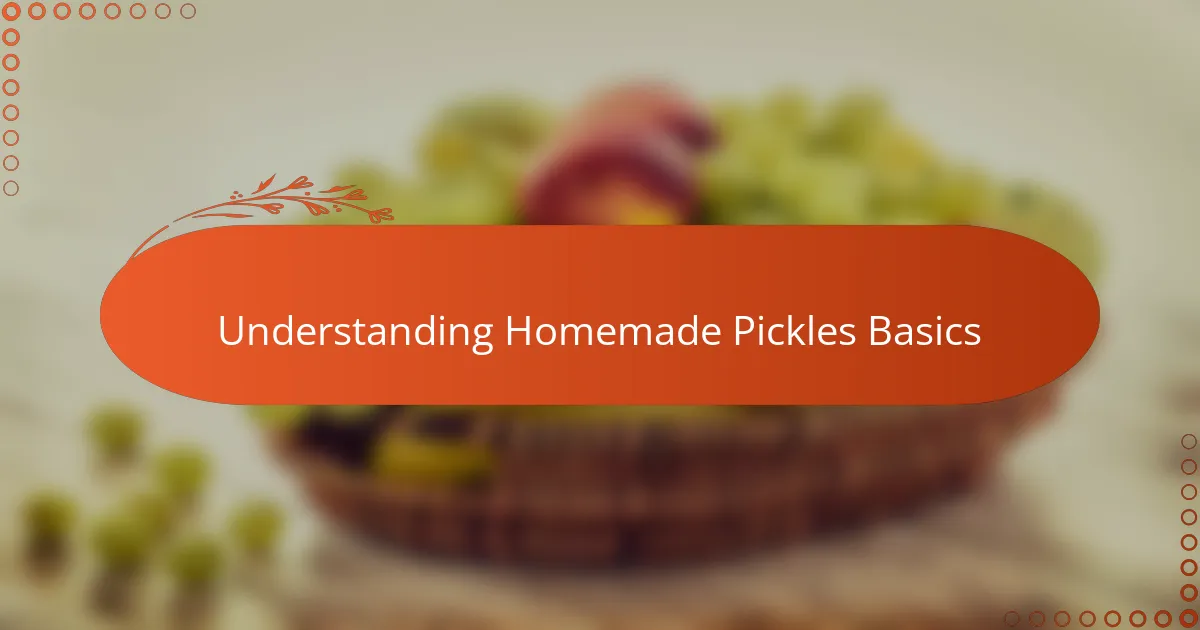
Understanding Homemade Pickles Basics
At its core, making homemade pickles is about preserving freshness and flavor in a simple jar. I remember the first time I tried—it was surprisingly straightforward, yet the magic was in balancing vinegar, water, salt, and a splash of sugar. Have you ever wondered why those basic ingredients create such a powerful transformation?
The key is the brine, which acts as both a preservative and a flavor enhancer. When I first learned about this, it felt almost a little mysterious how the right salt concentration prevents unwanted bacteria while encouraging the good ones to work their pickling magic. It’s a delicate dance, but once you get the proportions right, the results are consistently delicious.
Understanding the role of time is important too. Waiting for those cucumbers or other vegetables to soak up the brine can test your patience, but I’ve found the anticipation makes that first crunchy bite even more satisfying. It’s like a mini experiment in every jar—how long should you wait? In my experience, letting them sit for at least a week builds flavor depth you won’t want to miss.
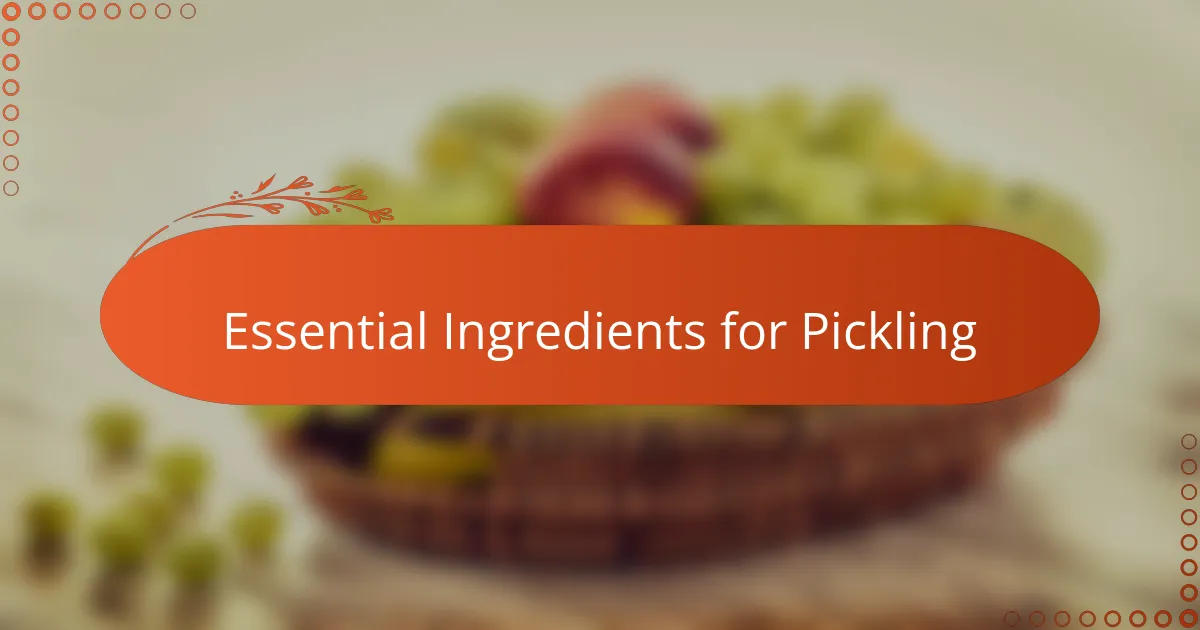
Essential Ingredients for Pickling
When I first gathered the essential ingredients for pickling, I realized it’s all about simplicity: vinegar, water, salt, and sometimes a bit of sugar. These basic staples create the perfect balance to preserve your veggies while letting their natural flavors shine through. Have you noticed how just a few pantry items can turn fresh cucumbers into something tangy and irresistible?
Salt is the unsung hero in pickling—the type and amount really make a difference. I remember experimenting with kosher salt versus pickling salt; the grain size affected how it dissolved and, ultimately, how crisp and flavorful my pickles turned out. It’s fascinating how such a small detail changes the entire jar.
Then there’s the vinegar, which not only adds zing but also acts as a preservative. I always recommend using a clear, distilled vinegar for a clean taste, but sometimes a splash of apple cider vinegar gives a lovely twist. Have you ever played around with different vinegars just to see how the flavor shifts? It’s one of those fun kitchen adventures that keeps pickling exciting every time.
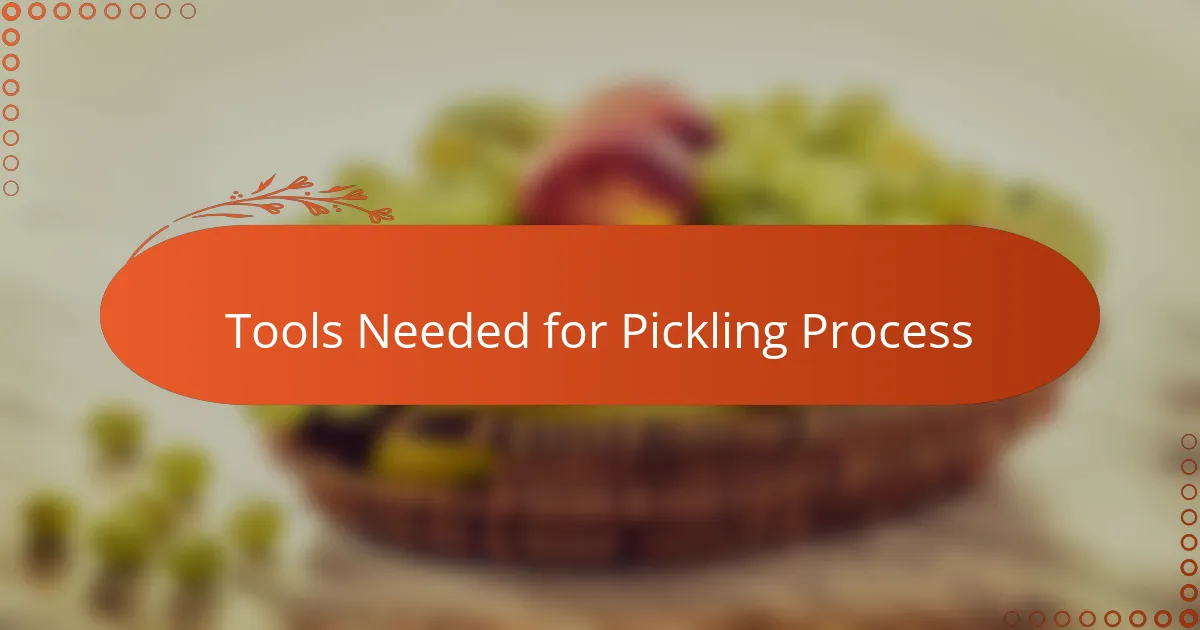
Tools Needed for Pickling Process
Having the right tools made a world of difference the first time I tackled pickling. I quickly learned that sturdy glass jars with tight-fitting lids are non-negotiable—they hold everything together and keep the pickles crunchy. Have you ever tried using old or flimsy containers? Trust me, it’s not worth the disappointment of leakage or spoilage.
Beyond jars, a good non-reactive pot for heating the brine is essential. I prefer stainless steel because it doesn’t impart any unwanted flavors. Plus, it’s easy to clean and durable—qualities I appreciate after several rounds of pickling experiments. Do you have a favorite pot that feels just right for this task?
Lastly, don’t underestimate simple items like a funnel and tongs. Using a funnel keeps everything neat when pouring hot brine, and tongs help maneuver your veggies safely into the jars without burning yourself. For me, these small tools transformed the process from clumsy to confident, making pickling feel more like a joyful ritual than a kitchen chore.
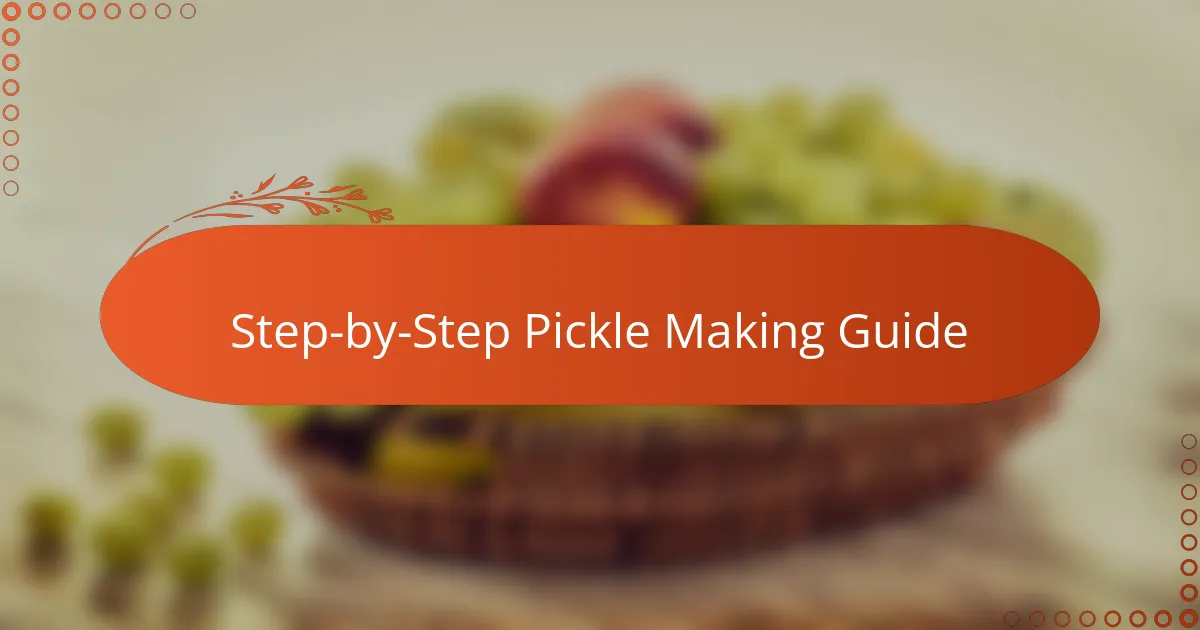
Step-by-Step Pickle Making Guide
The first step I take is to wash and slice my cucumbers, making sure they’re just the right size to fit comfortably in my jars. Have you ever noticed how oddly satisfying it is to prep veggies with a steady rhythm? That simple act sets the pace for the whole pickling process.
Next, I heat up the brine—a mix of vinegar, water, and salt—until everything dissolves and melds together beautifully. It’s like creating a magic potion, and I always stand over the pot, watching those bubbles rise, feeling a quiet excitement about the flavor to come.
Once the brine cools a bit, I carefully pack my jars with cucumbers and any spices I’m using, then pour the brine over until they’re fully submerged. Sealing the jars feels almost like tucking my pickles in for their little flavor vacation—you just know the wait ahead will be worth it.
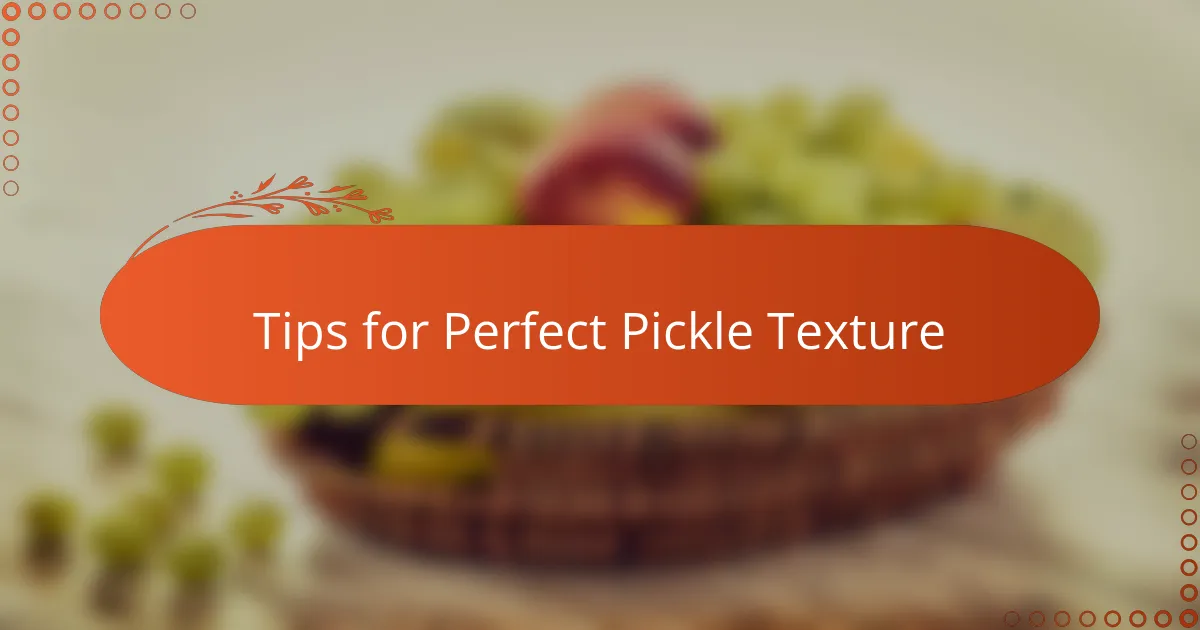
Tips for Perfect Pickle Texture
Getting that perfect pickle crunch starts with using fresh, firm cucumbers—I’ve found that going too soft or overripe can ruin the texture before you even begin. Have you noticed how the snap of a crisp cucumber can make a pickle feel alive? That initial bite is what I chase every time I jar up a batch.
Another game-changer for me has been temperature control during brining. I like to pour hot brine over the cucumbers, then let everything cool to room temp before sealing—this helps them stay crisp rather than turning mushy. It sounds simple, but this step changed my pickling results completely; the crunch just stays so much longer.
Lastly, salt type and quantity are subtle but crucial. I remember the first time I used pickling salt instead of table salt—it dissolved better and didn’t leave any grainy residue, which made the pickles feel fresher and crisper. Isn’t it amazing how tiny details like these can elevate your whole homemade pickle experience?
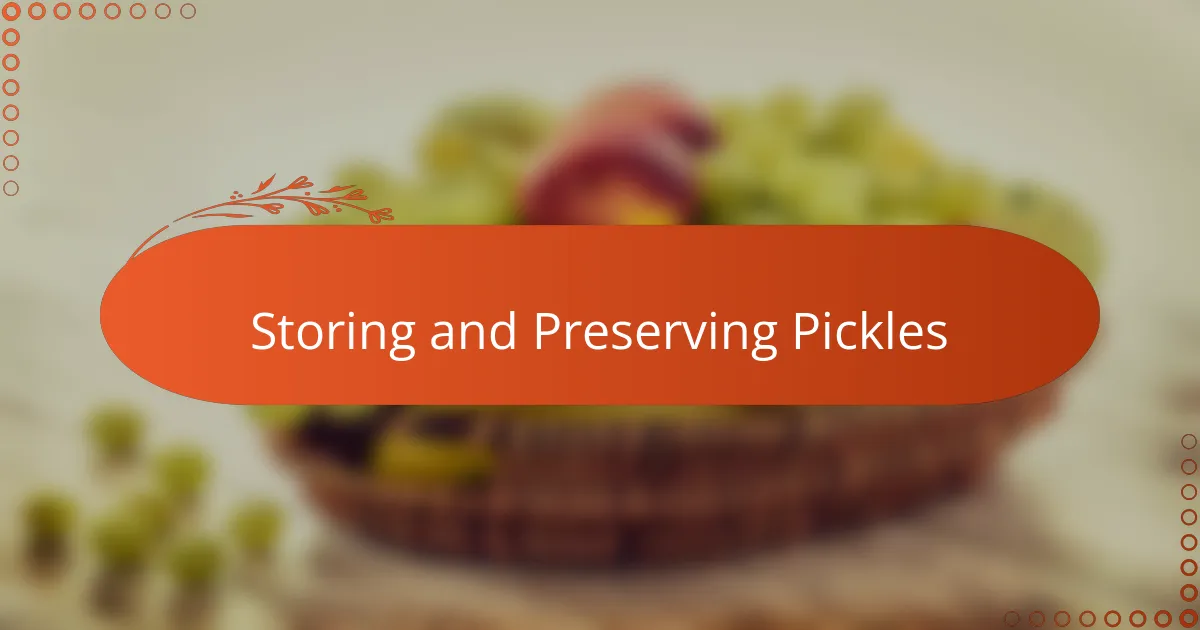
Storing and Preserving Pickles
Storing homemade pickles properly is key to keeping their fresh crunch and vibrant flavor for weeks or even months. From my experience, once the jars are sealed tightly, placing them in a cool, dark spot like a pantry or cellar works wonders. Have you ever noticed how sunlight seems to sap the life out of bright colors? It does the same with pickles, so shielding them from light preserves that inviting hue and taste.
Refrigeration after opening is a must in my kitchen routine. I learned the hard way that pickles left out too long lose their snap and can spoil faster. Keeping them cold prolongs their life and keeps the tang sharp, so reaching for that jar in the fridge feels just as rewarding as the first time you taste your creation.
Another trick I swear by is checking the seals before storing. I once found a jar where the lid hadn’t sealed properly, and the pickles fermented beyond my liking. It taught me to listen for that satisfying “pop” when opening a well-sealed jar—it’s a small moment of joy and assurance that your pickles are well preserved and ready to enjoy whenever you want.
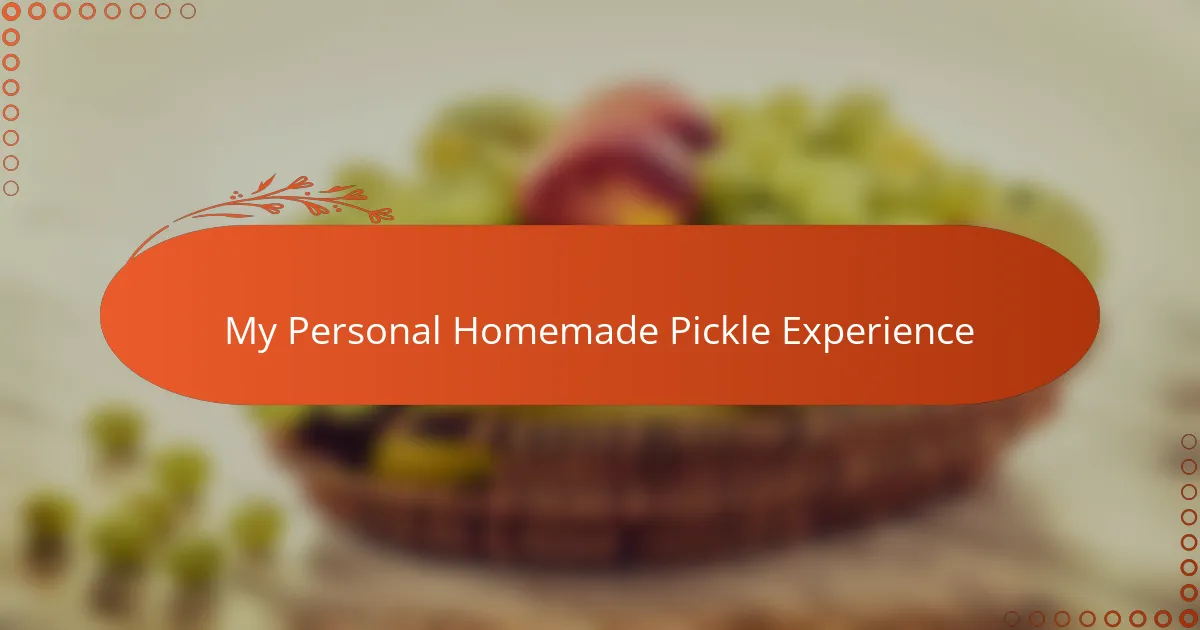
My Personal Homemade Pickle Experience
When I first made homemade pickles, I was honestly surprised by how rewarding the whole process felt. There’s something deeply satisfying about turning ordinary cucumbers into something tangy, crunchy, and full of flavor—all from my own kitchen. Have you ever experienced that sense of pride when a simple project turns out better than expected?
One memory that sticks with me is the moment I cracked open my very first jar. The aroma hit me, and that first bite brought a perfect snap—crisp and bursting with just the right balance of salt and vinegar. It felt like I’d uncovered a small kitchen secret, one that connected me to generations before me who preserved food with care and patience.
Of course, not every batch was flawless. I learned quickly that patience and attention to detail matter a lot, especially with timing and salt amounts. But each ‘imperfect’ jar taught me something new, and that exploration made the whole experience even more meaningful. Have you ever found that the little kitchen trials lead to the best home-cooked victories?
